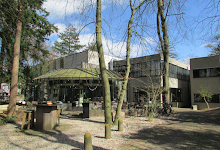Hocus Pocus was not Akkerman's first foray into novelty. In 1969 The Hunters were number one in Holland with a cold war inspired vocal number The Russian spy and I, featuring hot guitar work, in balalaika style, from Akkerman, then an up and coming 18 year old. Some may say ‘Niet’ but I would argue that it bears hearing today both as artifact of social and political history and attractive guitar virtuoso pop.
We have written of van Leer's humour but with Akkerman the humorous element is, if anything, more pronounced. In 1981 he made a solo album that is pure fun throughout. Apparently Oil in the Family was produced, perhaps uniquely, in just 48 hours in response to a Dutch radio producer’s challenge. Jan came up with what can best be described as a Middle Eastern disco record (one track is Disc-o-asis!) that is pure jest throughout. You may feel the joke is wearing thin by now but it still stands up as a good fun album.
There are plenty of other fun tracks too. It is difficult to listen without smiling to Green Onions (Guitar for Sale), Kemp’s jig and Minstrel/farmer’s dance (Profile), Crackers (available in several versions) or Quiet Storm (Art of Noise). There is even a track simply called Having Fun (also on Art of Noise). Until Flower Shower the Mother Focus track, I need the bathroom, (featuring a rare vocal from Akkerman himself?), was the wackiest item ever released by Focus.
Clearly in the making of most of Akkerman’s albums there has been plenty of laughter. Can’t stand noise originally had a closing track (Who knows) that ended rather abruptly. The story goes that the beautiful summer weather of 1983 prompted an attempt at outdoor recording. No sooner was everything set up for Akkerman to perform than a thunderclap announced a pending storm and everyone rushed back inside. The track Status Quo (From the Basement) ends with Dino Walcott breaking into fits of uncontrollable laughter. Jan explains in part "We were all standing together in the control room, while Dino was standing in the studio with his mouth organ. We were laughing our heads off, while the drum machine kept on going, and then Dino also started to laugh."
Akkerman loves punning (as in his trade mark ‘Thank you very Dutch’) and humour of a more unusual sort. His sense of fun comes out in several ways on albums. Even on a pretty serious album like Live at the Priory there are amusing remarks between songs (eg in response to the plea for more, ‘People. I’m dying for a fag!’). Occasionally, there has been jocund art work. The album cover where Jan shares his bed with an amorous guitar comes to mind as does the carefully conceived Noise of art jacket. I also like the two perspiring plastic pieces on the Transparental album with Kaz Luz and the In and out of Focus gatefold sleeve edition where the word Focus literally goes in and out of focus.
Word play often features. On Puccini’s Café, produced after a serious road accident, we find for the first time song writing credits to M Muleta. Who is Mr Muleta? Ask Jan and he will tell you it is his old lady or that it is the Spanish for a bull fighter’s cloak. Try saying ‘em-mue-later’ however and you might see the joke. It is a little like A. Rab credited on some Oil in the Family tracks. It’s Jan again, this time acknowledging an unknown Middle Eastern writer from whom he borrowed.
Some track and album titles are puns or jokes. The come back album Art of noise is a neat inversion. It includes the whimsical track title, You can’t keep a bad man up. Among bonus tracks released on three albums in 1998 we note, When I was a cocktail in a waitress bar, 39 seconds (that’s enough for that pilgrim), Akkermani and A town near Odessa (inspired by a town called Akkerman!). Think too of Ab-so-rocking-lutely, D.Jan.go and Knight of the lute on Passion.
Akkerman loves to rework tracks. This gives opportunity for droll punning. Heavy pleasure, Heavy treasure; Primadonna, Pre Madonna; Streetwalker, Weedstalker; Milestones, Akkerstones; not to mention Sylvia’s grandmother and Soft Focus or Birth and Early birth.
Again like elements pinpointed in other articles, humour is an important element in Akkerman’s music and a further part of what makes his body of work the phenomenon it is.

























